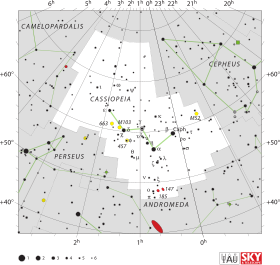HD 7924
HD 7924
| Ascension droite | 01h 21m 59,11373s[1] |
|---|---|
| Déclinaison | +76° 42′ 37,0382″[1] |
| Constellation | Cassiopée |
| Magnitude apparente | 7,167[2] |
Localisation dans la constellation : Cassiopée | |
| Type spectral | K0,5V[3] |
|---|---|
| Indice B-V | +0,826 ± 0,006[4] |
| Vitesse radiale | −22,624 km/s[5] |
|---|---|
| Mouvement propre |
μα = −34,767 mas/a[1] μδ = −32,724 mas/a[1] |
| Parallaxe | 58,812 5 ± 0,016 8 mas[1] |
| Distance | 17,003 0 ± 0,004 9 pc (∼55,5 al)[6] |
| Magnitude absolue | +6,04[4] |
| Masse | 0,81 ± 0,01 M☉[7] |
|---|---|
| Rayon | 0,74 ± 0,01 R☉[7] |
| Gravité de surface (log g) | 4,6 ± 0,01[7] |
| Luminosité | 0,364 ± 0,001 L☉[7] |
| Température | 5 216 ± 13 K[7] |
| Métallicité | −0,15 ± 0,03 [Fe/H][7] |
| Rotation | 0,9 km/s[8] |
| Âge | 3,0 ± 1,8 × 109 a[7] |
Désignations
HD 7924 est une étoile située dans la constellation de Cassiopée et distante de ∼ 55,5 a.l. (∼ 17 pc) de la Terre[1]. Il s'agit d'une naine orange de type spectral K0,5V[3]. C'est une étoile un peu moins massive, un peu moins grande, et moins lumineuse que le Soleil. Elle est l'hôte d'un système planétaire comprenant trois planètes connues.
Système planétaire
Trois exoplanètes, nommées HD 7924 b, HD 7924 c et HD 7924 d, sont en orbite autour HD 7924. La planète b a été découverte en 2009 et les planètes c et d en 2015[9]. Toutes trois sont des Super-Terres[10].
| Planète | Masse | Demi-grand axe (ua) | Période orbitale (jours) | Excentricité | Inclinaison | Rayon |
|---|---|---|---|---|---|---|
| b | 0,027 3 (± 0,001 7) MJ | 0,056 64 (± 0,000 69) | 5,397 92 (± 0,000 25) | 0,058 (+0,04 −0,056) |
1,05 RJ | |
| c | 0,024 7 (± 0,002 3) MJ | 0,113 4 (± 0,001 4) | 15,299 (± 0,003 3) | 0,098 (+0,069 −0,096) |
||
| d | 0,020 3 (± 0,002 5) MJ | 0,155 1 (± 0,001 9) | 24,451 (± 0,017) | 0,21 (± 0,13) |
Notes et références
- (en) A. Vallenari et al. (Gaia collaboration), « Gaia Data Release 3 : Summary of the content and survey properties », Astronomy & Astrophysics, vol. 674, , article no A1 (DOI 10.1051/0004-6361/202243940, Bibcode 2023A&A...674A...1G, arXiv 2208.00211). Notice Gaia DR3 pour cette source sur VizieR.
- ↑ (en) E. Høg et al., « The Tycho-2 catalogue of the 2.5 million brightest stars », Astronomy & Astrophysics, vol. 355, , L27-L30 (DOI 10.1888/0333750888/2862, Bibcode 2000A&A...355L..27H)
- (en) Kaspar von Braun et al., « Stellar diameters and temperatures - V. 11 newly characterized exoplanet host stars », Monthly Notices of the Royal Astronomical Society, vol. 438, no 3, , p. 2413–2425 (DOI 10.1093/mnras/stt2360, Bibcode 2014MNRAS.438.2413V, arXiv 1312.1792)
- (en) E. Anderson et Ch. Francis, « XHIP: An extended Hipparcos compilation », Astronomy Letters, vol. 38, no 5, , p. 331 (DOI 10.1134/S1063773712050015, Bibcode 2012AstL...38..331A, arXiv 1108.4971)
- ↑ (en) C. Soubiran et al., « Gaia Data Release 2. The catalogue of radial velocity standard stars », Astronomy & Astrophysics, vol. 616, , p. 8, article no A7 (DOI 10.1051/0004-6361/201832795, Bibcode 2018A&A...616A...7S, arXiv 1804.09370)
- (en) HD 7924 -- Star sur la base de données Simbad du Centre de données astronomiques de Strasbourg.
- (en) A. Bonfanti et al., « Revising the ages of planet-hosting stars », Astronomy & Astrophysics, vol. 575, , article no A18 (DOI 10.1051/0004-6361/201424951, Bibcode 2015A&A...575A..18B, arXiv 1411.4302, lire en ligne)
- ↑ (en) R. Earle Luck, « Abundances in the Local Region II: F, G, and K Dwarfs and Subgiants », The Astronomical Journal, vol. 153, no 1, , p. 19, article no 21 (DOI 10.3847/1538-3881/153/1/21, Bibcode 2017AJ....153...21L, arXiv 1611.02897)
- « The Extrasolar Planet Encyclopaedia — Catalog Listing », sur exoplanet.eu
- ↑ https://arxiv.org/pdf/1504.06629.pdf
